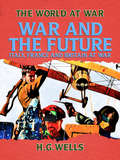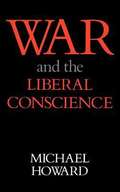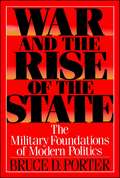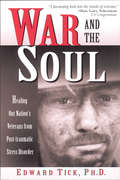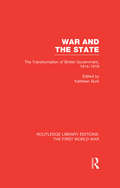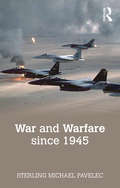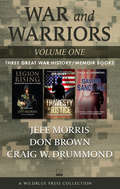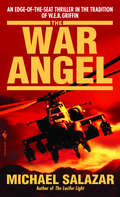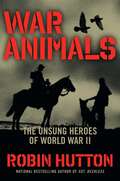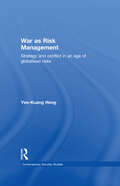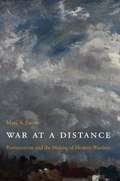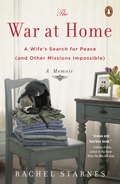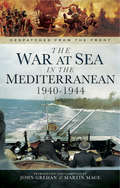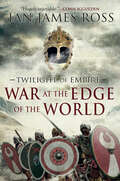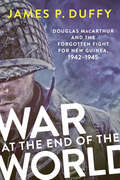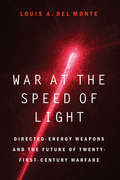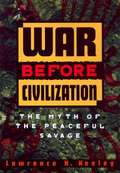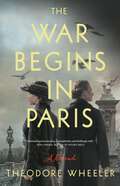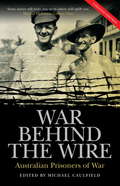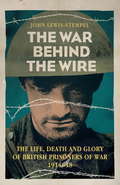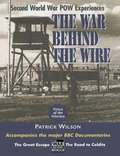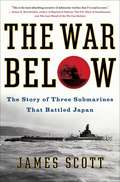- Table View
- List View
War and the Future: Italy, France And Britain At War (The World At War)
by H. G. WellsExcerpt: "One of the minor peculiarities of this unprecedented war is the Tour of the Front. After some months of suppressed information—in which even the war correspondent was discouraged to the point of elimination—it was discovered on both sides that this was a struggle in which Opinion was playing a larger and more important part than it had ever done before. This wild spreading weed was perhaps of decisive importance; the Germans at any rate were attempting to make it a cultivated flower. There was Opinion flowering away at home, feeding rankly on rumour; Opinion in neutral countries; Opinion getting into great tangles of misunderstanding and incorrect valuation between the Allies. The confidence and courage of the enemy; the amiability and assistance of the neutral; the zeal, sacrifice, and serenity of the home population; all were affected. The German cultivation of opinion began long before the war; it is still the most systematic and, because of the psychological ineptitude of the Germans, it is probably the clumsiest. The French Maison de la Presse is certainly the best organisation in existence for making things clear, counteracting hostile suggestion, the British official organisations are comparatively ineffective; but what is lacking officially is very largely made up for by the good will and generous efforts of the English and American press. An interesting monograph might be written upon these various attempts of the belligerents to get themselves and their proceedings explained."
War and the Liberal Conscience: The George Macaulay Trevelyan Lectures in the University of Cambridge, 1977
by Michael HowardThis book attempts to describe that in a rational, orderly world, wars would not exist: that they can be abolished, as slavery was abolished, by a collective effort of the conscience of mankind.
War and the Rise of the State
by Bruce D. PorterStates make war, but war also makes states.As Publishers Weekly notes, “Porter, a political scientist at Brigham Young University, demonstrates that wars have been catalysts for increasing the size and power of Western governments since the Renaissance. The state’s monopoly of effective violence has diminished not only individual rights and liberties, but also the ability of local communities and private associates to challenge the centralization of authority. Porter’s originality lies in his thesis that war, breaking down barriers of class, gender, ethnicity, and ideology, also contributes to meritocracy, mobility, and, above all, democratization. Porter also posits the emergence of the “Scientific Warfare State,” a political system in which advanced technology would render obsolete mass participation in war. This provocative study merits wide circulation and serious discussion.”
War and the Soul: Healing Our Nation's Veterans from Post-tramatic Stress Disorder
by Edward Tick<p>War and PTSD are on the public's mind as news stories regularly describe insurgency attacks in Iraq and paint grim portraits of the lives of returning soldiers afflicted with PTSD. These vets have recurrent nightmares and problems with intimacy, can't sustain jobs or relationships, and won't leave home, imagining "the enemy" is everywhere. <p>Dr. Edward Tick has spent decades developing healing techniques so effective that clinicians, clergy, spiritual leaders, and veterans' organizations all over the country are studying them. This book, presented here in an audio version, shows that healing depends on our understanding of PTSD not as a mere stress disorder, but as a disorder of identity itself. In the terror of war, the very soul can flee, sometimes for life. Tick's methods draw on compelling case studies and ancient warrior traditions worldwide to restore the soul so that the veteran can truly come home to community, family, and self.</p>
War and the State: The Transformation of British Government, 1914-1919 (Routledge Library Editions: The First World War)
by Kathleen BurkThis volume gives students and researchers an insight into British central government in 1914, how and why it altered during the war years and what permanent changes remained when the war was over. The war saw the scope of governmental intervention widened in an unprecedented manner. The contributors to this book analyse the reasons for this expansion and describe how the changes affected the government machine and the lives of the citizens. They consider why some innovations did not survive the coming of peace while others permanently transformed the duties and procedures of government.
War and the State: The Theory of International Politics
by R. Harrison WagnerWar and the Stateexposes the invalid arguments employed in the unproductive debate about Realism among international relations scholars, as well as the common fallacy of sharply distinguishing between conflict among states and conflict within them. As R. Harrison Wagner demonstrates, any understanding of international politics must be part of a more general study of the relationship between political order and organized violence everywhere--as it was in the intellectual tradition from which modern-day Realism was derived. War and the Statedraws on the insights from Wagner's distinguished career to create an elegantly crafted essay accessible to both students and scholars. "Possibly the most important book on international relations theory since Kenneth Waltz'sTheory of International Politics. " ---James Fearon, Stanford University "This is one of the best books on international relations theory I have read in a very long time. It is required reading for any student of modern IR theory. Once again, Wagner has shown himself to be one of the clearest thinkers in the field today. " ---Robert Powell, Robson Professor of Political Science, University of California, Berkeley "Painting on a vast canvas, and tackling and integrating topics such as state formation, domestic politics, and international conflict, R. Harrison Wagner'sWar and the Stateoffers many brilliant insights into the nature of international relations and international conflict. War and the Statecompellingly highlights the importance of constructing rigorous and valid theorizing and sets a high standard for all students of international relations. The field has much to gain if scholars follow the trail blazed by Wagner in this book. " ---Hein Goemans, University of Rochester R. Harrison Wagner is Professor of Government at the University of Texas.
War and Trade in the West Indies
by Richard ParesFirst published in 1963. Routledge is an imprint of Taylor & Francis, an informa company.
War and Warfare since 1945 (The Making of the Contemporary World)
by Sterling M. PavelecBeginning with an exploration into the question of what war is, War and Warfare since 1945 provides a chronological analysis of military history since the end of World War II extending through to an analysis of the limits of modern warfare in the nuclear age with the purpose of examining why war occurs and how it is carried out. Among the types of conflict considered within the book are: state conflicts civil wars proxy wars terrorism and counterterrorism insurgency genocide. Both theoretical and historical, War and Warfare since 1945 also explores the definitions, ethics, morals, and effects of the use of militaries in and after war, and puts forward important questions about how wars are resolved. The wars discussed include the first Arab-Israeli War, the Chinese Civil War, the Korean War, the Cold War, the Vietnam War, and the Iraq war. The book concludes with an investigation into modern war and speculation on the changing face of warfare.
War and Warriors Volume One: Legion Rising, Travesty of Justice, Saving Sandoval (War and Warriors #1)
by Jeff Morris Don Brown Craig W. DrummondThree real-life accounts of the struggles of American soldiers from the Iraq and Afghanistan battlefields to, in two cases, US military tribunals. Legion Rising: Surviving Combat and the Scars It Left Behind by Jeff Morris Follow Jeff through up-close, fast-paced accounts of the thrills and dangers of combat as a Platoon Leader in Iraq. Feel the weight of the gruesome and tragic loss of eight men whose lives were taken in the line of duty. Journey through his battle to face the scars and shadows that followed him long after his time serving in the military was over. Travesty of Justice: The Shocking Prosecution of Lt. Clint Lorance by Don BrownThe Book That Won a Presidential Pardon! On July 2, 2012, three Afghan males crowded on a motorcycle and sped down a Taliban-controlled dirt road toward Lt. Clint Lorance&’s men. In a split-second decision, Lorance ordered his men to fire. When no weapons were found on the Afghan bodies, the Army prosecuted Lorance for murder. &“The most powerful case to date for the exoneration of imprisoned Army Lt. Clint Lorance.&” —Sun-Sentinel Saving Sandoval by Craig W. Drummond While deployed in Iraq, Sandoval, an airborne infantryman and elite sniper, was instructed to &“take the shot&” and kill an enemy insurgent wearing civilian clothes. Two weeks later, Army Criminal Investigation Command descended upon Sandoval&’s unit, trying to link Sandoval and others to war crimes, including murder. &“A revealing, real-life courtroom drama, reminiscent of A Few Good Men.&” —Hunter R. Clark, International Law and Human Rights Program and Drake University Law School
The War Angel
by Michael SalazarElite Air Force Special Forces Pararescue Team operative Jason Johnson returns, taking on another impossible mission--this time in Afghanistan.
War Animals: The Unsung Heroes of World War II
by Robin HuttonMeet the forgotten members of the Greatest Generation. Today, war is a high-tech affair. The modern soldier relies on advanced weapons and communications technology as his essential support. But in World War II, soldiers relied on an entirely different kind of support—a kind of support soldiers have used since ancient times. Animals. Dogs, horses, and pigeons became World War II soldiers' best friends in battle, serving to carry weapons, wounded men, and messages through artillery fire. In War Animals, bestsellling author Robin Hutton brings the animal heroes of World War II to vivid life with the heroic true tales of: • Famed pigeon G.I. Joe, who saved an Italian village and British troops by flying 20 miles in 20 minutes to carry a message to Allied forces; • Chips, a German Shepherd trained as a sentry who attacked an Italian machine gun team, sustaining powder burns and saving his handler's life; • Bing, a paradog who jumped out of a plane on D-Day, landed in a tree, and once on the ground helped his handlers locate the enemy. A heartwarming and sometimes even hilarious history of bonafide heroes of feather and fur, War Animals is a World War II story you've never read before.
War as Risk Management: Strategy and Conflict in an Age of Globalised Risks (Contemporary Security Studies)
by Yee-Kuang HengThis major new study shows how war can be thought of in terms of proactive risk management rather than in terms of conventional threat response. It addresses why the study of ‘risk management’ has helped fields such as sociology and criminology conceptualize new policy challenges but has made limited impact on Strategic Studies with new case studies of recent Anglo-American military campaigns in Kosovo, Afghanistan and Iraq. The author shows how ‘risk' is now a key defining feature of our globalized era, encompassing issues from global financial meltdown, terrorism, infectious diseases, to environmental degradation and how its vocabulary, such as the Precautionary Principle, now permeates the way we think about war, and how it now appears in US and UK defence policy documents, and speeches from both civilian and military staff. This book will be of great interest to all students and scholars of strategic studies, war studies, international relations and globalization.
War at a Distance: Romanticism and the Making of Modern Wartime
by Mary A. FavretWhat does it mean to live during wartime away from the battle zone? What is it like for citizens to go about daily routines while their country sends soldiers to kill and be killed across the globe? Timely and thought-provoking, War at a Distance considers how those left on the home front register wars and wartime in their everyday lives, particularly when military conflict remains removed from immediate perception, available only through media forms.
The War at Home: A Memoir
by Rachel StarnesWhen she fell in love with her brother's best friend, Rachel Starnes had no idea she was about to repeat a painful family pattern--marrying a man who leaves regularly and for long stretches to work a dangerous job far from home. Through constant relocations, separations, and the crippling doubts of early parenthood, Starnes effortlessly weaves together strands from her past with the relentless pace of Navy life in a time of war. Searingly honest and emotionally unflinching--and at times laugh out loud funny--Starnes eloquently evokes the challenges she faces in trying to find and claim a sense of home while struggling to chart a new path and avoid passing on the same legacy to her two young sons. At once a portrait of the devastating strains that military life puts on families and a meditation on what it means to be left behind, The War at Home is a brave portrait of a modern military family and the realities of separation, endurance, and love that overcomes. Praise for The War at Home:"Rachel Starnes's The War at Home navigates the joys, fears, compromises, and casualties that create the terrain of marriage. And if you are a military spouse, her memoir will reveal thoughts you never even knew you had. This is a wise and fearless book." --Siobhan Fallon, author of You Know When the Men Are Gone "One of the most honest and genuine memoirs I've ever read, as well as one of the most finely written. There's not a false note in these pages. Rachel Starnes's story is at once both singular and emblematic. . . . The War at Home is that rare thing: a book about the here and now that promises to last well beyond next month or next year." --Steve Yarbrough, award-winning author of The Realm of Last Chances and Safe from the NeighborsFrom the Trade Paperback edition.
The War at Sea in the Mediterranean, 1940–1944 (Despatches From The Front Ser.)
by Martin Mace John GrehanDespatches in this volume include those covering the Battle of Matapan in 1941, Fleet Air Arm operations in 1940, the Battle of Sirte in 1942, the action with the Italian Fleet off Calabria (Central Mediterranean) in 1940, the engagement between British and Italian forces off Cape Spartivento (Central Mediterranean) in 1940, the Mediterranean convoys between January 1941 and August 1942 which includes the famous Operation Pedestal, operations in the Aegean in 1943, the engagement with an Italian convoy in 1941, and the despatch covering Coastal Force actions, including those in the Mediterranean.This unique collection of original documents will prove to be an invaluable resource for historians, students and all those interested in what was one of the most significant periods in British military history.The Coastal Forces despatch also includes those vessels assigned to the Levant, Dover and Nore stations i.e. outside of the Mediterranean theatre.
War at the Edge of the World: Twilight of Empire (Twilight Of Empire Ser. #1)
by Ian James RossA Roman centurion sent to the empire&’s distant northern edge encounters treachery beyond Hadrian&’s Wall in this historical epic series debut.Roman Britain, Fourth Century AD. Once a soldier in an elite legion from the Danube, newly promoted centurion Aurelius Castus now finds himself stuck in the provincial backwater of Britannia. Just beyond Hadrian&’s Wall are a savage people allied with Rome known as the Picts. When their king dies under mysterious circumstances, an envoy must be sent to negotiate with their new leader. And Castus is selected to command the envoy&’s bodyguard. What starts as a simple diplomatic mission ends in bloody tragedy. As Castus and his men fight for their lives, the legionnaire discovers that nothing about his doomed mission was ever what it seemed. The first book in Ian James Ross&’s Twilight of Empire series, War at the Edge of the World is an exciting debut from an author as gifted at telling a story as he is at bringing the Late Roman Empire to life.
War at the End of the World
by James P. DuffyA harrowing account of an epic, yet nearly forgotten, battle of World War II--General Douglas MacArthur's four-year assault on the Pacific War's most hostile battleground: the mountainous, jungle-cloaked island of New Guinea.One American soldier called it "a green hell on earth." Monsoon-soaked wilderness, debilitating heat, impassable mountains, torrential rivers, and disease-infested swamps--New Guinea was a battleground far more deadly than the most fanatical of enemy troops. Japanese forces numbering some 600,000 men began landing in January 1942, determined to seize the island as a cornerstone of the Empire's strategy to knock Australia out of the war. Allied Commander-in-Chief General Douglas MacArthur committed 340,000 Americans, as well as tens of thousands of Australian, Dutch, and New Guinea troops, to retake New Guinea at all costs.What followed was a four-year campaign that involved some of the most horrific warfare in history. At first emboldened by easy victories throughout the Pacific, the Japanese soon encountered in New Guinea a roadblock akin to the Germans' disastrous attempt to take Moscow, a catastrophic setback to their war machine. For the Americans, victory in New Guinea was the first essential step in the long march towards the Japanese home islands and the ultimate destruction of Hirohito's empire. Winning the war in New Guinea was of critical importance to MacArthur. His avowed "I shall return" to the Philippines could only be accomplished after taking the island.In this gripping narrative, historian James P. Duffy chronicles the most ruthless combat of the Pacific War, a fight complicated by rampant tropical disease, violent rainstorms, and unforgiving terrain that punished both Axis and Allied forces alike. Drawing on primary sources, War at the End of the World fills in a crucial gap in the history of World War II while offering readers a narrative of the first rank. From the Hardcover edition.
War at the Speed of Light: Directed-Energy Weapons and the Future of Twenty-First-Century Warfare
by Louis A. Del MonteWar at the Speed of Light describes the revolutionary and ever-increasing role of directed-energy weapons (such as laser, microwave, electromagnetic pulse, and cyberspace weapons) in warfare. Louis A. Del Monte delineates the threat that such weapons pose to disrupting the doctrine of Mutually Assured Destruction, which has kept the major powers of the world from engaging in nuclear warfare. Potential U.S. adversaries, such as China and Russia, are developing hypersonic missiles and using swarming tactics as a means to defeat the U.S. military. In response, the U.S. Department of Defense established the 2018 National Security Strategy, emphasizing directed-energy weapons, which project devastation at the speed of light and are capable of destroying hypersonic missiles and enemy drones and missile swarms. Del Monte analyzes how modern warfare is changing in three fundamental ways: the pace of war is quickening, the rate at which weapons project devastation is reaching the speed of light, and cyberspace is now officially a battlefield. In this acceleration of combat called &“hyperwar,&” Del Monte shows how disturbingly close the world is to losing any deterrence to nuclear warfare.
War Before Civilization
by Lawrence H. KeeleyThe myth of the peace-loving "noble savage" is persistent and pernicious. Indeed, for the last fifty years, most popular and scholarly works have agreed that prehistoric warfare was rare, harmless, unimportant, and, like smallpox, a disease of civilized societies alone. Prehistoric warfare, according to this view, was little more than a ritualized game, where casualties were limited and the effects of aggression relatively mild. Lawrence Keeley's groundbreaking War Before Civilization offers a devastating rebuttal to such comfortable myths and debunks the notion that warfare was introduced to primitive societies through contact with civilization (an idea he denounces as "the pacification of the past"). Building on much fascinating archeological and historical research and offering an astute comparison of warfare in civilized and prehistoric societies, from modern European states to the Plains Indians of North America, War Before Civilization convincingly demonstrates that prehistoric warfare was in fact more deadly, more frequent, and more ruthless than modern war. To support this point, Keeley provides a wide-ranging look at warfare and brutality in the prehistoric world. He reveals, for instance, that prehistorical tactics favoring raids and ambushes, as opposed to formal battles, often yielded a high death-rate; that adult males falling into the hands of their enemies were almost universally killed; and that surprise raids seldom spared even women and children. Keeley cites evidence of ancient massacres in many areas of the world, including the discovery in South Dakota of a prehistoric mass grave containing the remains of over 500 scalped and mutilated men, women, and children (a slaughter that took place a century and a half before the arrival of Columbus). In addition, Keeley surveys the prevalence of looting, destruction, and trophy-taking in all kinds of warfare and again finds little moral distinction between ancient warriors and civilized armies. Finally, and perhaps most controversially, he examines the evidence of cannibalism among some preliterate peoples. Keeley is a seasoned writer and his book is packed with vivid, eye-opening details (for instance, that the homicide rate of prehistoric Illinois villagers may have exceeded that of the modern United States by some 70 times). But he also goes beyond grisly facts to address the larger moral and philosophical issues raised by his work. What are the causes of war? Are human beings inherently violent? How can we ensure peace in our own time? Challenging some of our most dearly held beliefs, Keeley's conclusions are bound to stir controversy.
The War Begins in Paris: A Novel
by Theodore WheelerFrom the author of Kings of Broken Things and In Our Other Lives comes a "powerful, immersive" literary noir about two female World War II correspondents whose fates intertwine in Europe (Caitlin Horrocks). Paris, 1938. Two women meet: Mielle, a shy pacifist and shunned Mennonite who struggles to fit in with the elite cohort of foreign correspondents stationed around the city; the other, Jane, a brash, legendary American journalist, who is soon to become a fascist propagandist. When World War II makes landfall in the City of Lights, Mielle falls under Jane&’s spell, growing ever more intoxicated by her glamour, self-possession, and reckless confidence. But as this recklessness devolves into militarism and an utter lack of humanity, Mielle is seized by a series of visions that show her an inescapable truth: Jane Anderson must die, and Mielle must be the one to kill her. Structured as a series of dispatches filed from around Europe and based on the misadventures of a real journalist-turned-Nazi mouthpiece, The War Begins in Paris is a cat-and-mouse suspense that examines the relentlessness of propaganda, the allure of power, and how far one woman will go for the sake of her morality.
War Behind the Wire: Australian Prisoners of War
by Michael CaulfieldMichael Caulfield presents accounts of Australian prisoners of war, capturing the Aussie spirit that manages to endure through all.
The War Behind the Wire: The Life, Death and Glory of British Prisoners of War, 1914-18
by John Lewis-StempelOn capture, British officers and men were routinely told by the Germans 'For you the war is over'. Nothing could be further from the truth. British Prisoners of War merely exchanged one barbed-wire battleground for another.In the camps the war was eternal. There was the war against the German military, fought with everything from taunting humour to outright sabotage, with a literal spanner put in the works of the factories and salt mines prisoners were forced to slave in. British PoWs also fought a valiant war against the conditions in which they were mired. They battled starvation, disease, Prussian cruelties, boredom, and their own inner demons. And, of course, they escaped. Then escaped again. No less than 29 officers at Holzminden camp in 1918 burrowed their way out via a tunnel (dug with a chisel and trowel) in the Great Escape of the Great War.It was war with heart-breaking consequences; more than 12,000 PoWs died, many of them murdered, to buried in shallow unmarked graves.Using contemporary records - from prisoners' diaries to letters home to poetry - John Lewis-Stempel reveals the death, life and, above all, the glory of Britain's warriors behind the wire. For it was in the PoW camps, far from the blasted trenches, that the true spirit of the Tommy was exemplified.
The War Behind the Wire: Second World War POW Experiences (Voices of the Veterans)
by Patrick WilsonPublished to coincide with the major 2 part BBC1 series (Autumn 2000) of the same name, War Behind the Wire focuses on the capture, interrogation, the comradeship of camp life, escape planning and forgery techniques, tunnelling, the thrill of life on the run, re-capture and punishment, the joy of liberation. All these experiences and more are vividly described by former POWs of the Second World War and their German camp guards, in War Behind the Wire.Through gripping first-hand accounts enhanced with numerous illustrations, we learn the true story of the ill-fated Great Escape, which ended in the barbaric murder of 50 gallant men of many nationalities. Former inmates tell what life in Colditz Castle was really like.War Behind the Wire is an inspiring book of memories and experiences of those who never gave up hope. These will be as unforgettable for the reader as they were for those who found themselves in captivity.
The War Below: The Story of Three Submarines That Battled Japan
by James M. Scott“Beautifully researched and masterfully told” (Alex Kershaw, New York Times bestselling author of Escape from the Deep), this is the riveting story of the heroic and tragic US submarine force that helped win World War II in the Pacific.Focusing on the unique stories of three of the war’s top submarines—Silversides, Drum, and Tang—The War Below vividly re-creates the camaraderie, exhilaration, and fear of the brave volunteers who took the fight to the enemy’s coastline in World War II. Award-winning journalist James Scott recounts incredible feats of courage—from an emergency appendectomy performed with kitchen utensils to sailors’ desperate struggle to escape from a flooded submarine—as well as moments of unimaginable tragedy, including an attack on an unmarked enemy freighter carrying 1,800 American prisoners of war. The casualty rate among submariners topped that of all other military branches. The war claimed almost one out of every five submarines, and a submarine crewman was six times more likely to die than a sailor onboard a surface ship. But this valorous service accomplished its mission; Silversides, Drum, and Tang sank a combined sixty-two freighters, tankers, and transports. The Japanese were so ravaged from the loss of precious supplies that by the war’s end, pilots resorted to suicidal kamikaze missions and hungry civilians ate sawdust while warships had to drop anchor due to lack of fuel. In retaliation, the Japanese often beat, tortured, and starved captured submariners in the atrocious prisoner of war camps. Based on more than 100 interviews with submarine veterans and thousands of pages of previously unpublished letters and diaries, The War Below lets readers experience the battle for the Pacific as never before.

